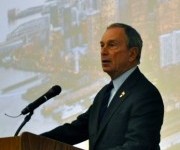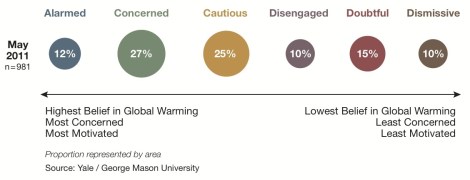
Andrew RedingClimate hawks must swoop in on public sentiment.
In a couple of posts last week — here and here — I laid out the brutal logic implied by the latest climate science (with credit to scientist Kevin Anderson for stripping away the rosy assumptions hiding in many of today’s common climate scenarios). To sum up: a rise in temperature of 2 degrees C (3.6 degrees F) will be extremely dangerous; a rise of 4 degrees C (7.2 degrees F) or higher could threaten civilization; the only way to avoid 2 degrees C — or even 4 degrees C — is a massive crash program that will likely involve, for the rich, industrialized countries of the world, peaking emissions in 2015 and declining them 10 percent year-on-year after that. Alarming!
In this post I want to take a step back (sideways?) and have a bit of a meta-discussion about messages of alarm/urgency and where they fit into the climate communications landscape.
Reaction to the posts has been interesting. I’ve gotten a ton of (mostly positive) emails and calls about them, had tons of Twitter and meatspace conversations, but as far as I know, nobody’s written about or reacted to them publicly. And I guess that’s not surprising. This kind of thing tends to end conversation like flatulence at a cocktail party. That’s part of why there’s a whole cottage industry devoted to urging climate hawks not to talk like this. What good can it do? Terrifying people just elicits all sorts of defense mechanisms — denial, disengagement, apathy, system justification, what have you. The forces at work are so colossal, so utterly out of scale with what any individual or group can hope to tackle, that the logical conclusion seems to be, “we’re f*cked.” Our overwhelming instinct is to … change the subject.
[grist-related tag=”brutal-logic” limit=”4″]
There’s plenty of social psychology work on these kinds of reactions; I’ve written about it myself. Nonetheless, it seems to me that work has been interpreted in a fairly crude way.
When people are confronted with a message of fear and crisis that sounds apocalyptic and outside the bounds of the status quo, they don’t like it! And that’s what they tell pollsters and survey takers. Lots of folks have concluded from this that they should avoid the language of fear and crisis.
The 10 percent threshold
I think that’s a misunderstanding of how social change works. For one thing, what’s relevant is not merely how people react to an out-of-bounds message-of-alarm (I need a handy word for that) at a given point, but how such messages become accepted (or don’t) over time. We need to look to more longitudinal studies, historical and anthropological studies, to understand the temporal dynamics of public opinion.
For another thing, what matters is not how such messages are received in isolation, but what role they can play in a larger communications strategy.
Let’s start with the first one. There’s long been an obsession among climate/energy folks with finding a message that appeals to to the “middle” (about which myths abound, but that’s a subject for another time) or the climate undecided/uncommitted/skeptical. Since honest (read: terrifying) talk about the severity of climate change doesn’t win over the uncommitted or disinterested, it is deemed unhelpful to that effort and scolded whenever it pops up.
As I’ve said so many times, though, what drives social change and shifts politics is not broad-based support but intensity. An intensely committed minority can act as a lever that moves larger populations. Scientists at the Rensselaer Polytechnic Institute did a study on this recently — “Social consensus through the influence of committed minorities” — that attempted to determine “the tipping point where a minority belief becomes the majority opinion.” They found that that it happens at right around 10 percent. (More precisely, they found that “when p<pc, Tc~exp[α(p)N], whereas for p>pc, Tc~lnN.” Which sounds about right.)
“When the number of committed opinion holders is below 10 percent, there is no visible progress in the spread of ideas. It would literally take the amount of time comparable to the age of the universe for this size group to reach the majority,” said SCNARC Director Boleslaw Szymanski, the Claire and Roland Schmitt Distinguished Professor at Rensselaer. “Once that number grows above 10 percent, the idea spreads like flame.”
As an example, the ongoing events in Tunisia and Egypt appear to exhibit a similar process, according to Szymanski. “In those countries, dictators who were in power for decades were suddenly overthrown in just a few weeks.”
This is one reason social change tends to be lurching and unpredictable: it’s often hard to tell when ideas outside the mainstream are nearing that 10 percent threshold.
It’s not necessarily a straightforward thing to transfer this finding on to the climate debate. By one measure — Yale’s “Six Americas” survey — climate hawks have already got 12 percent “alarmed.”
What complicates matters, of course, is that there’s a roughly equally sized (but vastly better funded and organized) cadre of people who are passionately intense about spreading doubt and blocking action. I’m not sure what the Rensselaer researchers would say about the spread of ideas in the face of concerted opposition, but I imagine it requires clearing a higher hurdle.
There’s this pretense among Very Serious People that the vast and wise middle “tunes out” the intense on both ends — that the extremes cancel each other out to no effect. That’s about half true, but it doesn’t mean what VSPs think it means.
VSPs tend to think the middle is full of commonsense folk looking for calm, measured, and sensible messages. But there’s no evidence for that at all. The great mass of Americans believe all sorts of crazy, wrongheaded, and mutually contradictory sh*t. What the average person wants is simply to take the path of least cognitive resistance, to believe what’s socially acceptable to believe, to believe what People Like Us believe. In a world filled with more information than any human being can absorb, it’s a sensible enough heuristic: believe with the herd. (I don’t mean that pejoratively; the vast bulk of my beliefs, and yours, are developed this way. There’s no other way to do it.)
The reason climate is such an uncomfortable topic for so many Americans is that it’s unresolved. There are these two opposing camps battling it out and it’s not yet clear what Normal People are supposed to think. That, not the “extremity” of any particular view, best explains why public opinion is shallow and fickle on the subject.
So it very much matters who wins that battle of intensity. That is how the Overton Window is shifted, how views from outside the mainstream come to be inside. The right gets this. Forty years ago, supply-side economics and opposition to basic social safety net protections were crank, extremist views held by a small minority of hardcore conservatives — the folks who rallied behind Goldwater in 1964 and lost. But as historian Rick Perlstein recounts in Before the Storm: Barry Goldwater and the Unmaking of the American Consensus, they didn’t stop. They kept organizing and pushing, organizing and pushing. Then came Nixon, Reagan, GW Bush, Sarah Palin. Now extremist conservative views are part of the mainstream fabric.
What if they’d given up after 1964? What if they’d looked at surveys, concluded the American middle didn’t favor their views, and spent the next decades trying to tone down and soften those views?
That’s where climate hawks are — their own 1964. Surely one of their most important tasks is to grow and support the committed minority of people who have absorbed and understood the severity of the climate crisis. From this perspective, it doesn’t matter if climate truth initially fails to reach the mushy middle. What matters is that the committed minority grows.
Hope without threat like yin without yang
So, what kind of message produces the kind of intensity and motivation we need?
Any effective political communications strategy needs three things: a victim, a villain, and hope. First, you have to convince the audience that they face a real, pressing danger. Then you identify the people and institutions behind the threat. Then you show how the villain(s) can be defeated and security restored.
The idea is to produce a sense of threat or unease — a cognitive and emotional itch that needs to be scratched — and simultaneously scratch it by offering a sense of hope, efficacy, and shared purpose. You will note that this is the basic theme of every right-wing email blast in the last 30 years: Secular socialists are brainwashing your children or attacking Christmas or raising your taxes, but if good people like us rally, we can protect our precious heritage (we can even protect our precious inefficient lightbulbs). It’s Communications 101, but it has eluded the climate community.
In part, that’s because climate change is a unique and difficult problem — “wicked,” as people never tire of calling it. It doesn’t sort neatly into good guys and bad guys; everyone consumes fossil fuels and eats food. Climate change seems distant, incremental, and abstract. It requires sacrificing today for benefits that will accrue to our descendants. It’s a psychological knot, to say the least.
Faced with these challenges, lots of people have decided, explicitly or implicitly, to skip the victim talk and the villain talk and cut straight to hope. We can create green jobs! Innovate and be economically competitive! Finally be independent of that pesky Middle Eastern oil! We don’t need to agree about climate change. We can bracket that unpleasant dispute for now.
But of course, if these goals are worth pursuing independently of climate change, one wonders why they haven’t been pursued with any urgency. We’ve been talking about energy independence for decades and haven’t begun to take the kind of action that might make us more energy self-sufficient.
Knocking people out of their tunnel-vision daily lives and into civic or political action — a necessary precondition for any action that’s not to the liking of status quo elites — requires more than hope for a better future; it also requires fear of losing what is now possessed. Terror that’s not accompanied by a road forward and a sense of efficacy just shuts people down, yes. But happy, inspiring possibilities unaccompanied by a threat fail to generate much passion or intensity.
It’s fashionable to say that apocalyptic doom and gloom “has been tried and failed.” But that is half-true at best. There was a brief period around 2007 when climate change was in the public consciousness. Al Gore’s movie had flashes of scary stuff — the notorious sea-swallowing-NYC bit — but it was far less apocalyptic than people have made it out in retrospect.
And what followed Gore’s movie? A two or three year period of relentless, puerile lifestyle content (including, ahem, the Vanity Fair green issue) devoted to convincing upscale American consumers that green is the next big thing. There were occasional newspaper articles, more in the U.K., in which climate scientists waved red flags, but the average American — who gets their news and cultural attitudes from TV — has not been exposed to anything scary at all about climate. Indeed, the vast majority of Americans, including American policymakers, have no conception whatsoever of how severe a problem climate change is.
That seems like a problem.
Pluralism and opportunism, motivated
Lots of things need to happen at once for us to have a chance on climate. I’m absolutely in support of pluralism (a variety of messages, strategies, and policies) and opportunism (taking whatever gains become available). I’m the farthest thing from a purist. The reason I’m insistent on pushing climate danger into the conversation is that I feel pretty strongly that building a core cadre of intense, motivated citizens who feel the climate threat in their bones is an indispensable part of the puzzle. Without that cadre organizing and pushing, dragging the Overton Window, modeling what real climate concern looks like, all the “pragmatic” strategies will add up to … not enough.
We can see a glimmer of that cadre forming in 350.org, the Keystone XL protests, the grassroots campaign against coal plants, and other bits and pieces. If things like TckTckTck and PowerShift are any indication, young people seem to get it. And of course climate movements are growing at the grassroots level all over the world.
There’s no reason that intensity, activism, protest, and agitation — “alarmism,” as they’re snottily called by Very Serious People — need to be seen a an alternative to pragmatic, incremental process pushed by moderate insiders. They are not mutually exclusive; indeed, they ought to be mutually reinforcing. At the very least, less infighting would be nice.
But everyone, it seems to me, no matter what role they play, could stand to push the edge a little bit occasionally, reminding their audience, whatever audience, that climate change is some genuinely dire sh*t and that now is the time for ambition and courage.




